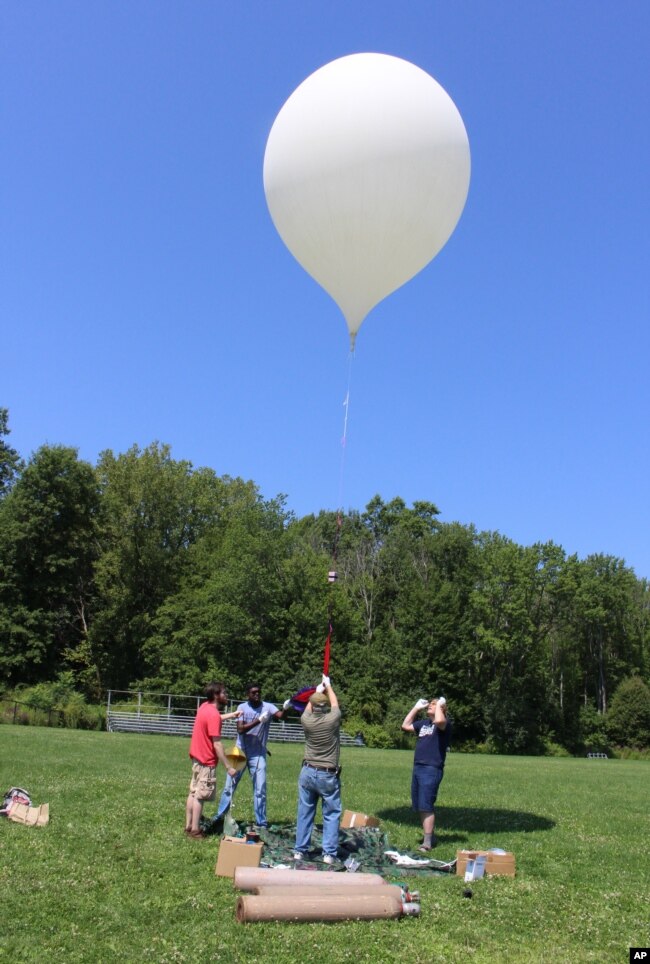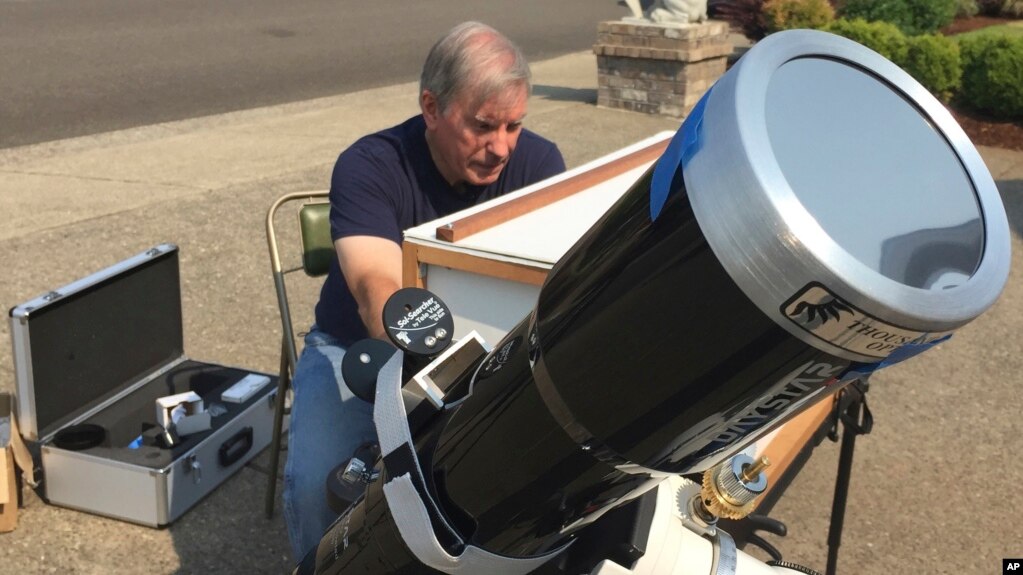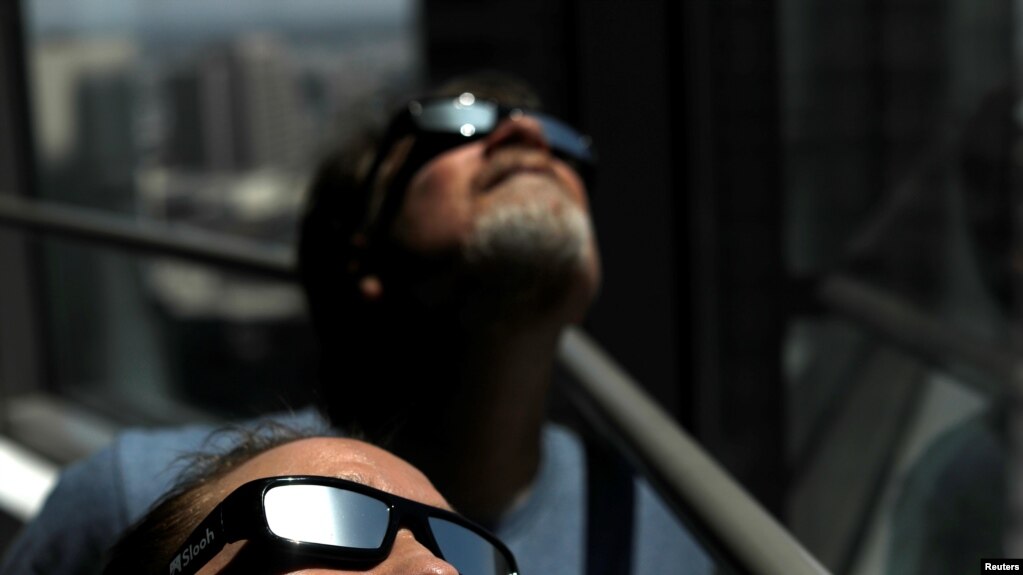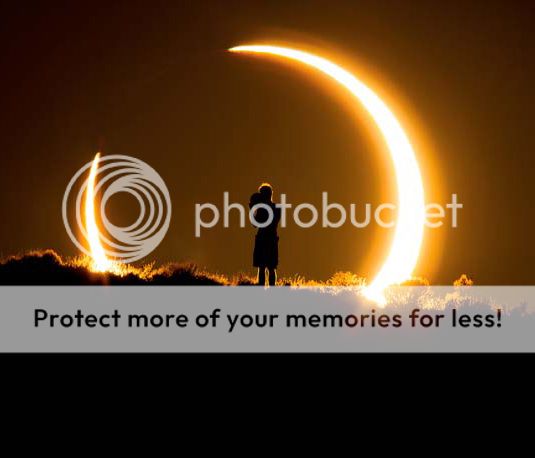Navigation
Install the app
How to install the app on iOS
Follow along with the video below to see how to install our site as a web app on your home screen.

Note: This feature currently requires accessing the site using the built-in Safari browser.
More options
You are using an out of date browser. It may not display this or other websites correctly.
You should upgrade or use an alternative browser.
You should upgrade or use an alternative browser.
Eclipse
- Thread starter SSDD
- Start date
darn clouds....
jon_berzerk
Platinum Member
- Mar 5, 2013
- 31,401
- 7,368
- 1,130
Anyone watching the Eclipse? Beautiful morning for it.
yup we got the grandson up early to view it
as a infant "moon" was his first word btw
the second was "cows"
Uncle Ferd got a welder's helmet to wear for the eclipse...

Citizen Scientists Gear Up for Eclipse
August 17, 2017 - The August 21 solar eclipse, the first to travel coast to coast in the United States in nearly a century, has inspired dozens of citizen science projects involving solar physics, atmosphere and biology. "Millions of people ... can walk out on their porch in their slippers and collect world-class data," said Matthew Penn, an astronomer with the National Solar Observatory in Tucson, Arizona.
See also:
Catch Solar Eclipse Online or on TV
August 16, 2017 — Ronald Dantowitz has been looking forward to Monday's solar eclipse for nearly 40 years.

Citizen Scientists Gear Up for Eclipse
August 17, 2017 - The August 21 solar eclipse, the first to travel coast to coast in the United States in nearly a century, has inspired dozens of citizen science projects involving solar physics, atmosphere and biology. "Millions of people ... can walk out on their porch in their slippers and collect world-class data," said Matthew Penn, an astronomer with the National Solar Observatory in Tucson, Arizona.
Penn is coordinating a citizen science effort to photograph the sun's volatile outer atmosphere, known as the corona. The corona's pearly light is typically obscured by the bright glare of the sun, but during a total eclipse, scientists can get a clear view of the outer crown, a mysterious region that triggers solar flares and other storms that can disrupt satellites, power grids and other systems on Earth. The view does not last long. Because the moon is moving at more than 2,000 mph (3,200 kph), it blocks the sun for only a couple of minutes, not long enough to detect key changes in the corona.
93-minute show
The eclipse will cast the moon's 70-mile-wide shadow, called the "path of totality," across the United States over 93 minutes, temporarily bringing darkness to daytime skies. Penn's project, called The Citizen Continental-America Telescopic Eclipse Experiment, or Citizen CATE, involves a network of volunteers who will be stationed along the path of the eclipse with identical telescopes to take digital photos of the corona. The pictures will later be spliced together into a 93-minute movie. Citizen CATE participants require special equipment and training, but dozens of other projects are open to anyone in the path of totality with a camera or cellphone.

An 8-foot camera-carrying balloon rises into the sky during a test launch at the University of Hartford in West Hartford, Conn., Aug. 9, 2017. A team from the University of Bridgeport and the University of Hartford conducted the test as part a project that will send cameras into the stratosphere to photograph this month's solar eclipse.
Google and the University of California-Berkley are teaming up for Eclipse Megamovie 2017, a crowdsourced compilation of eclipse imagery. For a project called Life Responds, the California Academy of Sciences wants field reports about how animals and plant life react during the eclipse. Using an app called iNaturalist, amateur scientists will log their observations and get help identifying flora and fauna. "We want to collect exactly what all these animals are doing as it gets dark -- what do we see, what do we hear," said University of Missouri astronomer Angela Speck. A number of zoos, wildlife preserves and 20 national parks are in the path of the eclipse.
EclipseMob
Another app-driven science project is called EclipseMob, organized by George Mason University in Virginia and the University of Massachusetts in Boston. It aims to collect information about radio waves passing through Earth's ionosphere, the electrically charged outer layer of the atmosphere. When sunlight is blocked during an eclipse, the ionosphere is suddenly transformed. Using home-built radio receivers and smartphones, participants will pick up radio waves transmitted by EclipseMob in Colorado and California and record how the signals change.

Amateur astronomer Mike Conley practices with the telescope he will use to document the Aug. 21 total solar eclipse, at his home in Salem, Ore., Aug. 3, 2017. Conley is part of a project led by the National Solar Observatory to have dozens of citizen scientists posted across the U.S. photograph the celestial event in an effort to create a live movie of its path that will help scientists learn more about the sun's corona.
Other apps will record temperature changes and monitor clouds. The National Aeronautics and Space Administration, the American Astronomical Society and the American Association for the Advancement of Science have lists of citizen science projects on their websites. "This is an opportunity to draw people from across the country into being fans of science," said astronomer Speck, co-chair of the American Astronomical Society's National Total Solar Eclipse Task Force. "The change in light is so fast and what you get to see is so amazing that even people who chase eclipses and have seen dozens of them will still be wowed by this," Speck said. "It's not just visual, it's an all-over experience."
Citizen Scientists Gear Up for Eclipse
See also:
Catch Solar Eclipse Online or on TV
August 16, 2017 — Ronald Dantowitz has been looking forward to Monday's solar eclipse for nearly 40 years.
An astronomer who specializes in solar imaging, he's been photographing eclipses for more than three decades, and will be using 14 cameras to capture the August 21 event. The cameras have solar filters to capture the eclipse in its partial phases, along with custom modifications that can photograph the corona and light wavelengths that are invisible to the human eye, allowing scientists to view and study the sun's temperature and composition in a way only possible during a total eclipse, he said. Dantowitz, who is based at Dexter Southfield School in Brookline, Massachusetts, is lending his expertise to NOVA's Eclipse Over America, airing at 9 p.m. EDT Monday on PBS. That hourlong special, which will incorporate his images, is among extensive coverage planned on TV and online of the first solar eclipse to cross the United States in 99 years.
Still, witnessing totality — when the sun is completely obscured by the moon — is best done with the naked eye, not a camera, Dantowitz said, adding that the total eclipse is safe to view without special lenses. (NASA warns that, except for the totality period, looking directly at the sun is unsafe; the only safe way to look directly at an uneclipsed or partly eclipsed sun is through special solar filters, or "eclipse glasses.") "Enjoying totality by eye is more rewarding," he said. "There is much to see: stars during the daytime, the million-degree solar corona, and seeing the sun blacked out during the daytime. "I have been waiting almost 40 years for this eclipse, and although I will be operating 14 cameras during totality, I will certainly take a moment to gaze at the eclipse the same way people have done for thousands of years: with wonder."

Solar eclipse sunglasses are pictured in Los Angeles
For those not in the 14 states in the eclipse's "path of totality," here's a look at some of the viewing opportunities online and on TV:
— Eclipse of the Century: In partnership with Volvo, CNN plans two hours of livestreaming, 360-degree coverage accessible in virtual reality through Oculus and other VR headsets beginning at 1 p.m. EDT. Accompanying television coverage will include reporting from Oregon, Missouri, Tennessee and South Carolina.
— Eclipse Over America: The PBS science series NOVA is planning a quick turnaround on its eclipse documentary premiering Monday. Senior executive producer Paula S. Apsell said Eclipse Over America, which delves into why eclipses occur and what scientists can learn from them, will incorporate images of the event from across the country shot earlier that day with Dantowitz's high-tech cameras.
— Great American Eclipse: The Science Channel will broadcast its live coverage from Madras, Oregon, from noon to 4 p.m. EDT, with commentary from educators and astronomers from the Lowell Observatory.
— The Great American Eclipse: David Muir will anchor ABC's two hours of live coverage, with correspondents reporting from viewing parties across the country. NBC also plans live coverage, with Lester Holt hosting special reports at 1 and 2 p.m. EDT featuring correspondents reporting from Oregon, Illinois, Wyoming and South Carolina. Shepard Smith will break into typical broadcasting on Fox News Channel from noon to 4 p.m. EDT to update viewers on the eclipse and introduce footage from NASA and observatories around the country.
— Solar Eclipse: Through the Eyes of NASA: NASA will offer hours of coverage online and on NASA Television beginning at noon Eastern. It plans livestreaming of the eclipse beginning at 1 p.m. EDT with images from satellites, research aircraft, high-altitude balloons and specially modified telescopes.
— The Total Solar Eclipse: The Weather Channel is kicking off its live coverage at 6 a.m. EDT and continuing throughout the day with dispatches from seven locations along the "path of totality."
Catch Solar Eclipse Online or on TV
jon_berzerk
Platinum Member
- Mar 5, 2013
- 31,401
- 7,368
- 1,130
that is coming up
thanks for the reminder
thanks for the reminder
Pop23
Gold Member
that is coming up
thanks for the reminder
Live about 30 minutes from where it will last the longest. Taking the day off to experience it. 40% chance of rain though
Bummer dudes
- Oct 19, 2012
- 61,250
- 59,522
- 3,635
This one will be a totally American eclipse, it will cross in a line,all the way from Oregon to South Carolina. West to East.
Eclipses are bizarre events.....they have always been associated with strange omens.
I have never seen a solar eclipse. ....Lucky those of you that will be able to witness it!
....Lucky those of you that will be able to witness it!
Eclipses are bizarre events.....they have always been associated with strange omens.
I have never seen a solar eclipse.
Last edited:
- Oct 19, 2012
- 61,250
- 59,522
- 3,635
that is coming up
thanks for the reminder
Live about 30 minutes from where it will last the longest. Taking the day off to experience it. 40% chance of rain though
Bummer dudes
I hope it will not rain where you are, so you are able to watch it!

Billy_Bob
Diamond Member
Its apex is happening at about 12:21 mountain time on Monday above Wyoming ... I'm all set to take photos with the NASA crew that is in my area...Anyone watching the Eclipse? Beautiful morning for it.
jon_berzerk
Platinum Member
- Mar 5, 2013
- 31,401
- 7,368
- 1,130
that is coming up
thanks for the reminder
Live about 30 minutes from where it will last the longest. Taking the day off to experience it. 40% chance of rain though
Bummer dudes
I hope it will not rain where you are, so you are able to watch it!
me too
jon_berzerk
Platinum Member
- Mar 5, 2013
- 31,401
- 7,368
- 1,130
a funny piece of news in regards to the eclipse
--LOL
Utilities General Manager Ed Shikada said the eclipse will cause an estimated loss of 4,194 megawatts of California large-scale solar electricity and Palo Alto gets 30 percent of its electricity from such sources.
Solar system generation will go from about 64 to 83 percent capacity at the start of the eclipse down to about 15 to 37 percent at the height of the eclipse, according to the California Energy Commission.
Palo Alto asks residents to power down for solar eclipse
--LOL
Utilities General Manager Ed Shikada said the eclipse will cause an estimated loss of 4,194 megawatts of California large-scale solar electricity and Palo Alto gets 30 percent of its electricity from such sources.
Solar system generation will go from about 64 to 83 percent capacity at the start of the eclipse down to about 15 to 37 percent at the height of the eclipse, according to the California Energy Commission.
Palo Alto asks residents to power down for solar eclipse
Billy_Bob
Diamond Member
It has the potential to crash the California grid... and maybe some others. Cali has bought generator time from Wyoming in the millions of dollars to offset their failure to produce.. IF the lights stay on, its because of a few large coal fired power plants....a funny piece of news in regards to the eclipse
--LOL
Utilities General Manager Ed Shikada said the eclipse will cause an estimated loss of 4,194 megawatts of California large-scale solar electricity and Palo Alto gets 30 percent of its electricity from such sources.
Solar system generation will go from about 64 to 83 percent capacity at the start of the eclipse down to about 15 to 37 percent at the height of the eclipse, according to the California Energy Commission.
Palo Alto asks residents to power down for solar eclipse
The Original Tree
Diamond Member
It is the first time in American history we have had a meteor shower, a lunar eclipse, and a full solar eclipse in the same month in America.
Perseid Meteor Shower Wows Stargazer with 'One-in-a-Million' Fireball
Partial Lunar Eclipse on August 7/8, 2017 – Where and When to See
Visualization of the August 21, 2017 Total Solar Eclipse
Perseid Meteor Shower Wows Stargazer with 'One-in-a-Million' Fireball
Partial Lunar Eclipse on August 7/8, 2017 – Where and When to See
Visualization of the August 21, 2017 Total Solar Eclipse
Last edited:
jon_berzerk
Platinum Member
- Mar 5, 2013
- 31,401
- 7,368
- 1,130
It has the potential to crash the California grid... and maybe some others. Cali has bought generator time from Wyoming in the millions of dollars to offset their failure to produce.. IF the lights stay on, its because of a few large coal fired power plants....a funny piece of news in regards to the eclipse
--LOL
Utilities General Manager Ed Shikada said the eclipse will cause an estimated loss of 4,194 megawatts of California large-scale solar electricity and Palo Alto gets 30 percent of its electricity from such sources.
Solar system generation will go from about 64 to 83 percent capacity at the start of the eclipse down to about 15 to 37 percent at the height of the eclipse, according to the California Energy Commission.
Palo Alto asks residents to power down for solar eclipse
yes indeed
but you will be unlikely to hear about that in the news
--LOL
Billy_Bob
Diamond Member
Another one of those cyclical events... One thing that hasn't happened in the last 1,000 years however, is the alignment of 4 planets, the sun and the moon on the same plane. One of the things NASA is going to be measuring is the pull on the earths surface at apex. The last few months USGS has repaired many of their seismic and tilt monitoring stations just for this event.Much to do about a shadow! Think I will go fishing. I wonder if the eclipse will have any effect on the fish bitting!
Could this massive pull trigger seismic events?
Similar threads
- Replies
- 5
- Views
- 158
- Replies
- 9
- Views
- 219
Latest Discussions
- Replies
- 91
- Views
- 745
- Replies
- 17
- Views
- 89
- Replies
- 74
- Views
- 244
- Replies
- 631
- Views
- 4K
- Replies
- 216
- Views
- 3K
Forum List
-
-
-
-
-
Political Satire 8068
-
-
-
-
-
-
-
-
-
-
-
-
-
-
-
-
-
-
-
ObamaCare 781
-
-
-
-
-
-
-
-
-
-
-
Member Usernotes 471
-
-
-
-
-
-
-
-
-
-


